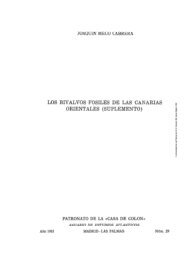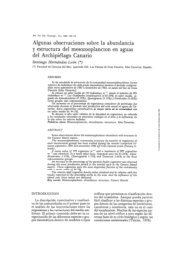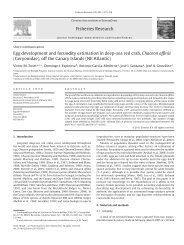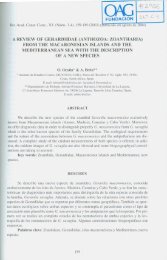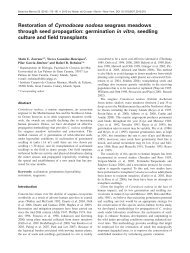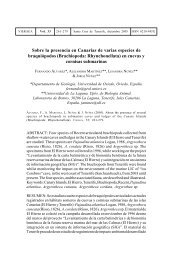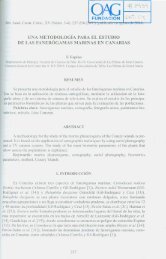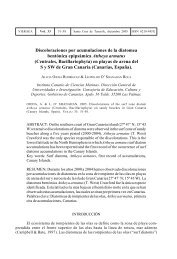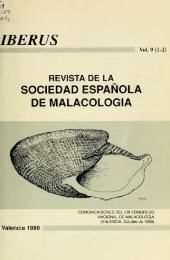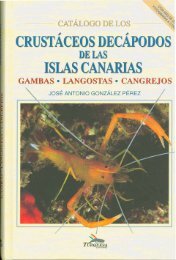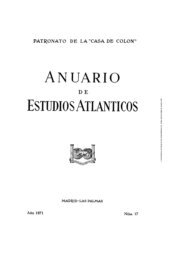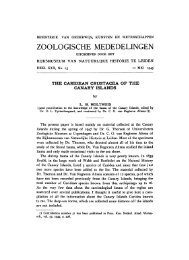of the madeira and selvagens archipelagos - redmic
of the madeira and selvagens archipelagos - redmic
of the madeira and selvagens archipelagos - redmic
You also want an ePaper? Increase the reach of your titles
YUMPU automatically turns print PDFs into web optimized ePapers that Google loves.
S<br />
30<br />
25<br />
20<br />
15<br />
10<br />
5<br />
0<br />
Asteraceae<br />
Brassicaceae<br />
Lamiaceae<br />
Fabaceae<br />
Crassulaceae<br />
Figura 2. Número de taxa (S) de plantas vasculares endémicas dos arquipélagos da Madeira e das Selvagens por famílias.<br />
Figure 2. Number <strong>of</strong> endemic vascular plant taxa (S) by family in <strong>the</strong> Madeira <strong>and</strong> Selvagens <strong>archipelagos</strong>.<br />
No que concerne aos endemismos partilhados com<br />
outros arquipélagos da Macaronésia (endemismos da Macaronésia),<br />
ocorrem 74 taxa distribuídos por 44 famílias (a<br />
20% das famílias apenas correspondem 42% dos taxa)<br />
e 66 géneros, sendo os géneros com maior diversidade:<br />
Hypericum L. (Hypericaceae), com 3 taxa; Lotus L. (Fabaceae),<br />
Asplenium L. (Aspleniaceae), Rumex L. (Polygonaceae),<br />
Lolium L. (Poaceae), Rubus L. (Rosaceae) e Huperzia<br />
Bernh. (Lycopodiaceae), com 2 taxa. A análise da distribuição<br />
geográfica destes endemismos permite concluir que<br />
os arquipélagos da Madeira e Selvagens partilham, com as<br />
Canárias, 65 taxa, com os Açores, 16, e, com Cabo Verde,<br />
apenas 9 taxa. Estes números parecem comprovar a inexistência<br />
da Macaronésia como região biogeográfica, reforç<strong>and</strong>o<br />
a classificação biogeográfica proposta por Rivas-<br />
-Martínez et al. (1993 e referências incluídas).<br />
Os taxa nativos e nativos prováveis constituem o maior<br />
grupo de plantas vasculares dos arquipélagos da Madeira<br />
e Selvagens (respectivamente 480 e 66 taxa). Distribuem -se<br />
por 78 famílias, sendo que a 20% das famílias (16), correspondem<br />
385 taxa, i.e., 71% do total. As 3 famílias com<br />
maior número de taxa são: Poaceae (73), Fabaceae (67) e<br />
Asteraceae (49). Dos 283 géneros de taxa nativos e nativos<br />
prováveis, os mais diversos são: Trifolium L. (21 taxa, Fabaceae),<br />
Juncus L. (13 taxa, Juncaceae) e Vicia L. (9 taxa,<br />
Fabaceae).<br />
No que respeita às plantas vasculares introduzidas (e<br />
naturalizadas como antes se referiu) as famílias com maior<br />
número de taxa são as Poaceae, Asteraceae e Fabaceae<br />
(Fig. 3). No total ocorrem 430 taxa a que correspondem 401<br />
taxa introduzidos e 29 introduzidos prováveis. Os taxa in-<br />
Scrophulariaceae<br />
Poaceae<br />
Rosaceae<br />
Apiaceae<br />
Aspidiaceae<br />
Liliaceae<br />
Campanulaceae<br />
Ericaceae<br />
165<br />
Geraniaceae<br />
Famílias (families)<br />
Orchidaceae<br />
Saxifragaceae<br />
Aspleniaceae<br />
Boraginaceae<br />
Cyperaceae<br />
Euphorbiaceae<br />
The Macaronesian endemics, 74 taxa, belong to 66 genera<br />
in 44 families (20% <strong>of</strong> <strong>the</strong> families representing 42% <strong>of</strong><br />
total taxa). Hypericum L. (Hypericaceae) is <strong>the</strong> most diverse<br />
genus with 3 taxa, Lotus L. (Fabaceae), Asplenium L. (Aspleniaceae),<br />
Rumex L. (Polygonaceae), Lolium L. (Poaceae),<br />
Rubus L. (Rosaceae) <strong>and</strong> Huperzia Bernh. (Lycopodiaceae)<br />
present 2 Macaronesian endemic taxa each. The analysis<br />
<strong>of</strong> <strong>the</strong> spatial distribution <strong>of</strong> <strong>the</strong>se endemics shows that <strong>the</strong><br />
<strong>archipelagos</strong> <strong>of</strong> Madeira <strong>and</strong> Selvagens share 65 taxa with<br />
<strong>the</strong> Canary Isl<strong>and</strong>s, 16 taxa with <strong>the</strong> Azores <strong>and</strong> only 9 taxa<br />
with Cape Verde. These numbers seem to substantiate <strong>the</strong><br />
idea that Macaronesia should not be considered as a single<br />
biogeographical region, reinforcing <strong>the</strong> biogeographical<br />
scheme proposed by Rivas -Martínez et al. (1993 <strong>and</strong> references<br />
<strong>the</strong>rein).<br />
Native <strong>and</strong> “possible native” taxa are <strong>the</strong> larger groups <strong>of</strong><br />
vascular plants from <strong>the</strong> Madeira <strong>and</strong> Selvagens <strong>archipelagos</strong><br />
(respectively with 480 <strong>and</strong> 66 taxa). These taxa belong<br />
to 78 families, but it was interesting to find that 16 families<br />
(corresponding to <strong>the</strong> 20% most diverse families) have 385<br />
taxa, i.e., 71% <strong>of</strong> total taxa. The families with <strong>the</strong> highest<br />
number <strong>of</strong> taxa are Poaceae (73), Fabaceae (67) <strong>and</strong> Asteraceae<br />
(49). Among <strong>the</strong> 283 genera that include native or<br />
“possible native” taxa, three are <strong>the</strong> most diverse: Trifolium<br />
L. (with 21 taxa, Fabaceae), Juncus L. (with 13 taxa, Juncaceae)<br />
<strong>and</strong> Vicia L. (with 9 taxa, Fabaceae).<br />
For <strong>the</strong> introduced (<strong>and</strong> naturalised) vascular plants, <strong>the</strong><br />
highest number <strong>of</strong> taxa was recorded for <strong>the</strong> Poaceae, Asteraceae<br />
<strong>and</strong> Fabaceae (Fig. 3). Among <strong>the</strong> 430 taxa reported<br />
in this category, 401 taxa are considered introduced while<br />
29 are identified as “possible introduced”. The introduced<br />
Oleaceae<br />
Plantaginaceae<br />
Plumbaginaceae<br />
Polygonaceae<br />
Solanaceae<br />
Outras famílias (18)



